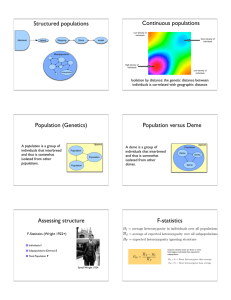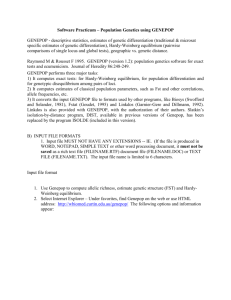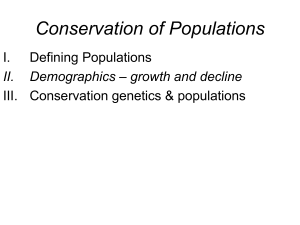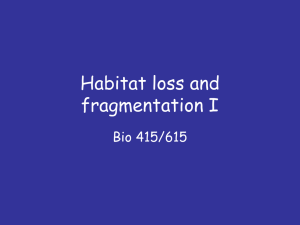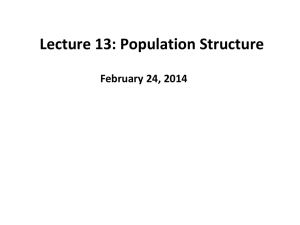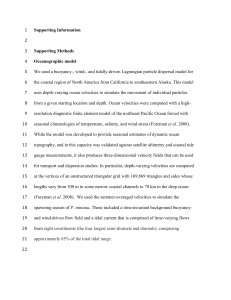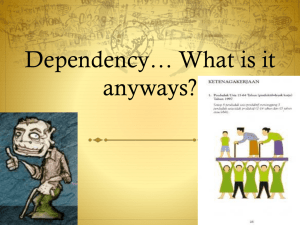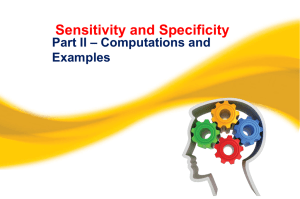Document
advertisement
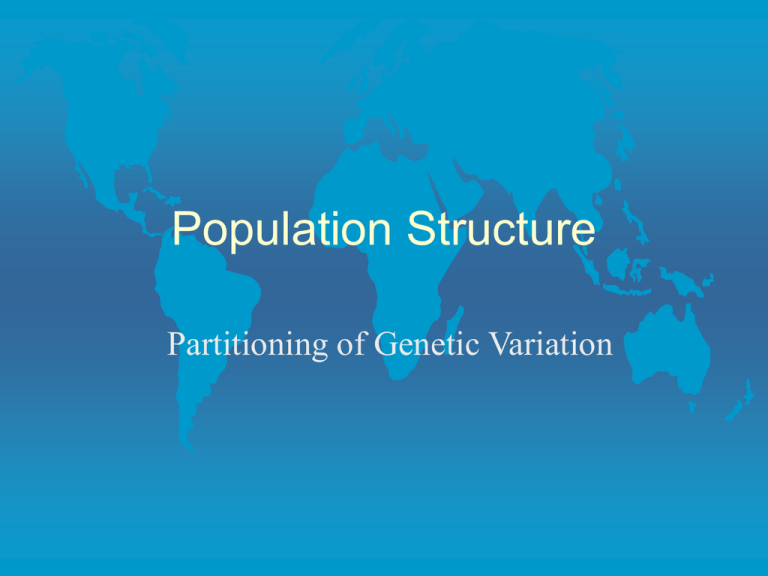
Population Structure
Partitioning of Genetic Variation
Banner-tailed kangaroo rat
(Dipodomys spectabilis)
Distribution of populations
SSW
1 km
R2
Distribution of populations
1 km
Distribution of populations
1 km
Distribution of populations
1 km
Population Structure
Hierarchical
Population Structure
– Partitioning of the
genetic variation
between the different
groupings of
individuals
Hierarchical levels
–
–
–
–
Total population
Subpopulation
Breeding groups
Individuals
Distribution of populations
Are the two populations in
HaWeE?
pa=1.0
pA=1.0
We trap animals in the box
and catch approximately
equal numbers of animals
from the two population.
Is the population now in
HaWeE?
No, deficient in heterozygotes!
Population subdivision results
in fewer heterozygotes than we
would expect if only 1 population
Ursus maritimus
North Beaufort Sea
South Beaufort Sea
Davis Strait
Western Hudson Bay
North Beaufort Sea
Western Population
South Beaufort Sea
Eastern Population
Western Hudson Bay
Davis Strait
North Beaufort Sea
South Beaufort Sea
Total Population
Davis Strait
Western Hudson Bay
Heterozygosity within
Populations
Calculate H at each
hierarchical level
– Populations
– Hlocus = (1-(∑pi2))
– HS = (I=1∑n Hlocus)/n
n = Number of loci
Heterozygosity within populations
SB
G1A
G1D
G10B
G10C
G10L
G10M
G10P
G10X
0.742
0.612
0.767
0.244
0.317
0.796
0.697
0.838
H= 0.627
NB
WH
DS
0.755
0.631
0.740
0.391
0.332
0.758
0.687
0.741
0.632
0.451
0.602
0.433
0.691
0.491
0.782
0.777
0.711
0.617
0.406
0.607
0.639
0.486
0.348
0.736
0.754
0.820
0.599
Heterozygosity within Regions
Calculate H at each
hierarchical level
– Regions
– Estimate average allele
frequency within each
region
– Hlocus
= 1-( j=1∑a(I=1∑Rpi/R)2
R = # regions
a = # alleles
– HR = (I=1∑n Hlocus)/n
n = Number of loci
Weight this value by the
number of populations in
each region.
Heterozygosity within Regions
Western
G1A
G1D
G10B
G10C
G10L
G10M
G10P
G10X
0.766
0.624
0.772
0.321
0.327
0.801
0.697
0.811
H= 0.640
Eastern
0.435
0.605
0.548
0.607
0.422
0.764
0.784
0.770
0.617
Heterozygosity Total
Calculate H at each
hierarchical level
– Total
– Estimate average allele
frequency within each
region
– Hlocus
= 1-( j=1∑a(I=1∑SPpi/SP)2
SP = # subpopulations
a = # alleles
– HT = (I=1∑n Hlocus)/n
n = Number of loci
Heterozygosity Total
Total
G1A
G1D
G10B
G10C
G10L
G10M
G10P
G10X
0.709
0.618
0.750
0.488
0.376
0.800
0.760
0.816
H= 0.665
Comparison of Hexp at various
levels
0.75
0.7
0.65
0.6
0.55
0.5
SB
NB
WH
DS
WEST
EAST TOTAL
Who Cares??
Study of statistical differences among local populations
is an important line of attack on the evolutionary
problem. While such differences can only rarely
represent first steps toward speciation in the sense of
the splitting of the species, they are important for the
evolution of the species as a whole. They provide a
possible basis for intergroup selection of genetic
systems, a process that provides a more effective
mechanism for adaptive advance of the species as a
whole than does the mass selection which is all that can
occur under panmixia. Sewall Wright.
Translation
Population subdivision reduces population
size.
Reduced population size increases genetic
drift which decreases genetic diversity or
increases inbreeding
Different populations will then diverge from
each other with the possibility of speciation
Inbreeding
Inbreeding
– Animals prefer to mate
with individuals more
closely related to them
than a random
individual
– Decreases
heterozygosity
– Reduces genetic
variation
– Sexual Selection
Inbreeding
– Animals mate at random
but there are a limited
number of mates from
which to choose due to
population subdivision.
– Decreases heterozygosity
– Reduces genetic variation
– Genetic Drift
Wright’s F-stats
Fixation Index (F)
– Quantifies inbreeding due to population
structure
Reduction in H due to structure
– Estimates the reduction in H expected at one
level of the hierarchy relative to another
more inclusive level.
– FSR - Decrease in H given that the regions are
divided into subpopulations
– FST - Decrease in H given the that the whole
system is not panmictic.
– FST = ? in panmictic population?
– FST = ? in completely isolated populations?
FSR
HR H S
HR
FRT
HT H R
HT
FST
HT HS
HT
HS
0.627 0.632 0.617 0.599
0.619
4
HR
0.640 0.617
0.628
2
H T 0.665
FSR
HR H S
HR
FRT
HT H R
HT
FST
HT HS
HT
Of the total genetic variation found in the
4 major polar bear populations only 7% is
due to the subdivision of the population.
FSR
0.628 0.619
0.014
0.628
FRT
0.665 0.628
0.056
0.665
FST
0.665 0.619
0.069
0.665
Interpreting F-stats
FST = 0 - 0.05
– Little genetic differentiation
FST = 0.05 - 0.15
– Moderate genetic differentiation
FST = 0.15 - 0.25
– Great genetic differentiation
FST = > 0.25
– Very great differentiation
Interpreting F-stats
FST = 0 - 0.05
– F=1/(1+4Nm)
– Nm={(1/F)-1}*0.25
– If F = 0.15
– Little genetic diff.
FST = 0.05 - 0.15
– Moderate genetic diff.
FST = 0.15 - 0.25
FST = > 0.25
– Very great diff.
Nm = {(1/0.15)-1}*0.25
Nm = (6.67-1)*0.25
Nm = 1.4
One migrant per generation will
prevent great genetic
differentiation or fixation of
different alleles
– Great genetic diff.
Recall
Isolation Breaking
The Wahlund Principle
If Population subdivision leads to a
reduction in the number of expected
heterozygotes it must also result in a greater
number of homozygotes than expected.
When isolation is broken homozygosity
decreases
Isolation Breaking
The Wahlund Principle
pa=1.0
aa = 0.5
Aa = 0.0
AA = 0.5
pA=1.0
pa=0.5
aa = 0.25
Aa = 0.5
AA = 0.25
pA= 0.5
Isolation Breaking
The Wahlund Principle
pa=1.0
pA=1.0
P(a) = q1
P(a) = q1
P(aa) = q12 P(aa) = q12
pa=1.0
pA= 1.0
P(a) = q1 + q2
P(aa) = {(q1 + q2)/2}2
={(1.0 + 0.0)/2}2
Average = (q12 + q22)/2
=0.25
(12 + 02)/2 = 0.5
Frequency of homozygotes decreases after fusion
Isolation Breaking
The Wahlund Principle
aa = 0.5
pa=1.0
pA=1.0
pA= 1.0
pa=1.0
aa = 0.5 => 0.25
Fusing separated populations reduces the average frequency of
each homozygote by an amount equal to the variance in allele
frequency among the original populations following random mating.
Var(q) = 0.5(q1 - qavg)2 + 0.5(q2 - qavg)2
= 0.5(1.0 - 0.5)2 + 0.5(0 - 0.5)2
= 0.5*0.25 + 0.5*0.25
= 0.25
F and Wahlund
The reduction in homozygosity
due to fusion
Thus the F-stats at each of
the hierarchical levels are
related to the variances of
the allele frequencies
grouped at the levels of
interest.
Given this we can
calculate the average
genotype frequencies
across populations….
– 2* 2
(assumes 2 alleles what would it
be with more alleles??)
This must equal the increase in
heterozygosity
HT - HS of
FST = (HT-HS)/HT
FST = (2*2)/HT
HT = 2pq
FST = 2 / 2pq
Genotypes in Subdivided populations
In subdivided
populations it is
possible to calculate
the average genotype
frequencies across all
populations
AA p 2 p q FST
Aa 2 p q 2 p q FST
The genotypes across
the subpopulations
don’t obey HaWeE
– Excess homozygotes
The genotypes within
the subpopulations do
obey HaWeE.
aa q 2 pq FST
Remember,
FST = 2 / 2pq and FST is the reduction in heterozygosity due to subdivision
The other Inbreeding
Selective mating between
close relatives
– The effect of inbreeding is
to reduce the
heterozygosity of a
population
– Defined as, “F - The
proportionate reduction in
heterozygosity relative to
random mating”.
Analagous to our
population subdivision
but it is within a
subpopulation
F = (HO - HI)/HO
– HO = 2pq Why?
HI = HO-HOF
=HO(1-F)
=2pq(1-F)
Inbreeding
In inbreed populations
it is possible to
calculate the expected
genotype frequencies
in an analagous
fashion to subdivision
AA p pqF
2
Aa 2 pq 2 pqF
The genotypes don’t
obey HaWeE
– Deficiency of
heterozygotes = 2pqF
These are allocated
equally amongst the
two homozygotes
because each
heterozygote as an
“A” and an “a”
aa q 2 pqF
Remember,
F is the reduction in heterozygosity due to inbreeding
2
Ai Ai pi (1 F ) pi F
Ai A j 2 pi qi (1 F )

